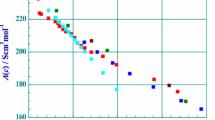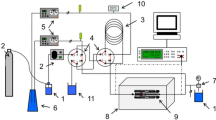Abstract
The transference numbers of HCl in water at 25°C have been determined up to 8 mol-kg−1 by using cells with transference. The problem of the solubility of AgCl from Ag/AgCl electrodes was avoided by employing dilute chlorine gas/iridium electrodes for T H and hydrogen gas/platinum electrodes for T Cl . The sums of the independently measured T H and T Cl values never differed from unity by more than 0.9%. The cation constituent transference number of HCl was also measured at 1M by the recently modified moving boundary method, but at higher concentrations the Soret effect produced unacceptably large current dependences. Combination of these transference numbers with literature conductances, diffusion coefficients and activity coefficients led to a new set of phenomenological transport coefficients l ij . The resulting curve for l12/c vs. c behaves more normally than did the curve based on previous transference numbers.
Similar content being viewed by others
References
M. Spiro and F. King, ‘Transport Properties in Concentrated Aqueous Electrolyte Solutions’, inIonic Liquids, D. Inman and D. G. Lovering, eds. (Plenum Press, New York, 1981), Chap. 5.
H. S. Harned and E. C. Dreby,J. Am. Chem. Soc. 61, 3113 (1939).
S. Lengyel, J. Giber, and J. Tamás,Acta Chim. Acad. Sci. Hung. 32, 429 (1962).
A. Seidell,Solubilities of Inorganic and Metal Organic Compounds (Van Nostrand, New York, 1940), 3rd edn., Vol. 1.
S. Lengyel, inElectrolytes, B. Pesce, ed. (Pergamon Press, Oxford, 1962), p. 208.
F. King and M. Spiro,J. Solution Chem. 10, 881 (1981).
P. N. Snowdon and J. C. R. Turner,Trans. Faraday Soc. 56, 1409 (1960).
R. Haase, P.-F. Sauermann, and K.-H. Dücker,Z. Physik. Chem., Frankfurt 47, 224 (1965).
G. Jones and B. C. Bradshaw,J. Am. Chem. Soc. 54, 138 (1932).
J. R. Gwyther, S. Kumarasinghe, and M. Spiro,J. Solution Chem. 3, 659 (1974).
W. J. Hamer and H. J. DeWane,Nat. Stand. Ref. Data Ser., Nat. Bur. Stand. No. 33 (1970).
L. Nickels and A. J. Allmand,J. Phys. Chem. 41, 861 (1937).
M. Postler,Coll. Czech. Chem. Comm. 35, 535 (1970).
J. N. Agar, ‘Thermogalvanic Cells’, inAdvances in Electrochemistry and Electrochemical Engineering, P. Delahay, ed. (Interscience, New York, 1963), Vol. 3, Chap. 2.
L. G. Longsworth,J. Am. Chem. Soc. 54, 2741 (1932).
C. Samis,Trans. Faraday Soc. 33, 469 (1937).
G. S. Kell, private communication (1961).
R. H. Stokes and B. J. Levien,J. Am. Chem. Soc. 68, 333 (1946).
G. Faita, P. Longhi, and T. Mussini,J. Electrochem. Soc. 114, 340 (1967).
F. C. Rubio, F. D. Gonzalez, V. M. Jimenez, and J. A. C. Paniagua,Ann. Quim. 76, 397 (1980).
A. C. Wright, private communication, (1982).
A. M. Feltham and M. Spiro,Chem. Rev. 71, 177 (1971).
R. A. Robinson and R. H. Stokes,Electrolyte Solutions (Butterworths, London, 1959), 2nd edn., Appendix 8.10.
M. J. Pikal and D. G. Miller,J. Phys. Chem. 74, 1337 (1970).
G. Akerlöf and T. W. Teare,J. Am. Chem. Soc. 59, 1855 (1937).
R. Fernández-Prini and J. E. Prue,J. Phys. Chem. 69, 2793 (1965).
M. Lucas,Bull. Soc. Chim. France 1792 (1969).
M. Spiro and A. B. Ravnö,J. Chem. Soc. 78 (1965).
M. Spiro, ‘Mixture Potentials in Chemistry’, inThe Physical Chemistry of Solutions, D. V. Fenby and I. D. Watson, eds. (Massey University Press, Palmerston North, New Zealand, 1983).
D. G. Miller,J. Phys. Chem. 70, 2639 (1966).
R. H. Stokes,J. Am. Chem. Soc. 72, 2243 (1950).
L. G. Longsworth,J. Am. Chem. Soc. 57, 1185 (1935).
D. G. Miller,Faraday Disc. Chem. Soc. 64, 295 (1977).
M. Spiro,Faraday Disc. Chem. Soc. 64, 345 (1977).
Author information
Authors and Affiliations
Rights and permissions
About this article
Cite this article
King, F., Spiro, M. Transference numbers and phenomenological transport coefficients for concentrated aqueous hydrochloric acid solutions at 25°C. J Solution Chem 12, 65–81 (1983). https://doi.org/10.1007/BF00650713
Received:
Accepted:
Issue Date:
DOI: https://doi.org/10.1007/BF00650713




